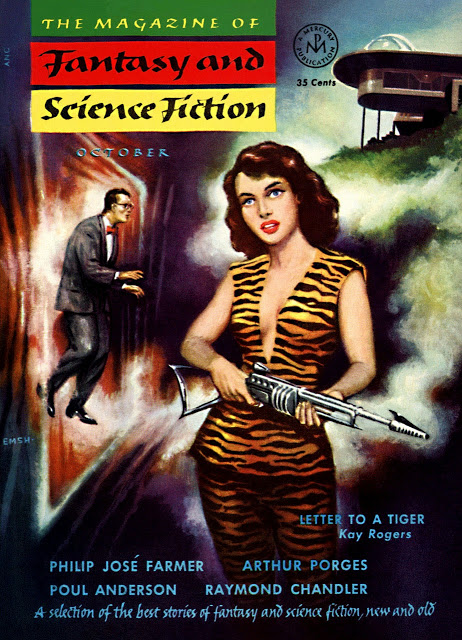 Writing the conclusion to a story can be hard! First off, the whole story has been leading to this last page, so the sense of responsibility to the story and to the reader is huge. I don’t want to end the story on a lame note, and I don’t want the readers to feel cheated, as if my story was a shaggy dog joke whose only point was in seeing how long I could keep them paying attention with the promise of a punch line that would never come.
Writing the conclusion to a story can be hard! First off, the whole story has been leading to this last page, so the sense of responsibility to the story and to the reader is huge. I don’t want to end the story on a lame note, and I don’t want the readers to feel cheated, as if my story was a shaggy dog joke whose only point was in seeing how long I could keep them paying attention with the promise of a punch line that would never come.
Brrr!
I know writers who never finish a story because their fear of screwing it up is too great. And I’ve also read some stories that looked like they were going great until they reached their unsatisfying ending, which blew the whole story. *(check the note on this at the end)
And you know what? Writers’ fears are justified. The ending IS most of the reason for the story’s existence. I know, I know, I know . . . the journey is fun too, certainly in a novel there have to be little payoffs along the way, and who hasn’t read a book where they were ten pages from the end and they were just sad as hell that the story was going to finish? So there’s something to be said for middles too, but the ending still has to be right.
How do you end the story you’re working on you ask? Sorry, can’t tell you for sure. Every story tends to its own ending, but I can share some principles that make sense to me.
- The conclusion should wrap up the conflicts introduced at the story’s beginning. If the story starts with a question, the end answers it. If it is a mystery, the end solves it. If there is a threat, it is remove or carried out. If an action is initiated, it’s completed. If a journey is started, the travelers arrive. In other words, the end of the story should be like the solution to an equation the story has set up. Of course, sometimes the question isn’t answered, or the travelers never arrive, but the ending then is about the significance of not answering or not arriving.
- Many stories are about reversals. Whatever conditions exist at the beginning of the story are swapped. The humble have become great, the rich have become poor, the proud have been brought down, and the sad have become happy. Look at “A Christmas Carol,” “Sleepless in Seattle,” “Star Wars” (the first one), ” “Cinderella,” etc.
- Some stories are not about reversing the initial conditions, but about getting back to them, except now the beginning is meaningful. The Lord of the Rings ends with Sam saying, “Well, I’m back,” and the implication is the world has been made right, or at least the Shire has. Ending where you began is a very effective technique, by the way. Nothing signals a reader more loudly that the story is over than to be back where you started.
- The last words of a story should be “bigger” than the words by themselves would be. The whole rest of the story exists to give the last words context, and this is where their “bigness” comes from.
- I’ll take a risk here and make a generalization: all effective endings work symbolically. The ending could be a symbolic line of dialog, or a symbolic action, or a symbolic gesture. In this sense, “symbolic” means “meaningful.” At the end of Steinbeck’s The Pearl, the villager throws the now hated pearl into the sea. His action is symbolic (and meaningful) because it shows him rejecting all the values the pearl has come to represent in the story.
One way to help with endings is to remember that a story isn’t written the way it is read. Readers start a piece not knowing the end, so they don’t know why details are there or where they are going. Writers, however, if they didn’t know the end when they started, they certainly know the end when they finish, and when they revise, they revise with the ending in mind. That means as a writer, once you get to your ending, you have the chance (the obligation) to go back and set it up. Writers who know this are effective rewriters. They know that if the first ending they wrote doesn’t work, that they can write a new one that does and then go back into the story to set it up. Revision can be everything. Trust the revision.
Here are three of my favorite endings of all time. If you go back and look at your favorite stories or novels, reread the ending and ask yourself why they are so good. You might teach yourself something about finishing a piece.
From “The Fall of the House of Usher,” by Edgar Allan Poe
From that chamber and from that mansion, I fled aghast. The storm was still abroad in all its wrath as I found myself crossing the old causeway. Suddenly there shot along the path a wild light, and I turned to see whence a gleam so unusual could have issued; for the vast house and its shadows were alone behind me. The radiance was that of the full, setting, and blood-red moon, which now shone vividly through that once barely discernible fissure, of which I have before spoken as extending from the roof of the building, in a zigzag direction, to the base. While I gazed, this entire orb of the satellite burst at once upon my sight–my brain reeled as I saw the mighty walls rushing asunder–there was a long tumultuous shouting sound like the voice of a thousand waters–and the deep and dank tarn at my feet closed sullenly and silently over the fragments of the ‘House of Usher.’
From “Flowers for Algernon,” by Daniel Keyes
Good-by Miss Kinnian and Dr Strauss and evreybody. And P.S. please tell Dr Nemur not to be such a grouch when pepul laff at him and he woud have more frends. Its easy to make frends if you let pepul laff at you. Im going to have lots of frends where I go.
P.P.S. Please if you get a chanse put some flowrs on Algernons grave in the bak yard . . .
From “Fondly Fahrenheit,” by Alfred Bester
But we know one truth. We know they were wrong. The new robot and Vandaleur know that because the new robot’s started twitching too. Reet! Here on cold Pollux, the robot is twitching and singing. No heat, but my fingers writhe. No heat, but it’s taken the little Talley girl off for a solitary walk. A cheap labor robot. A servo-mechanism . . . all I could afford . . . but it’s twitching and humming and walking alone with the child somewhere and I can’t find them. Christ! Vandaleur can’t find me before it’s too late. Cool and discrete, honey. In the dancing frost while the thermometer registers 10° fondly Fahrenheit.
*(note from earlier) Actually it’s rare that I read a story that is wonderful until it botches the ending. I think there is a relationship between knowing what you are doing well enough in the middle that the middle is good, and writing a good ending. You can be sure, though, when I edit, if everything is wonderful until the end, that I will ask for a rewrite.

 I’ve become increasingly a believer in getting out of your head and into the world to improve writing. Sometimes the easiest way to to do this is to read more. I’m surprised at how many writers I talk to who are trying to grow themselves as writers who have given up on their youthful reading habits. It turns out that reading time and writing time exactly overlap, so they quit reading. Argh! Big mistake! For myself, I have to keep reading to clear my head of my own rhythms and to remind myself that’s there’s many ways to assemble sentences and stories. Good movies or television can get me out of my head too.
I’ve become increasingly a believer in getting out of your head and into the world to improve writing. Sometimes the easiest way to to do this is to read more. I’m surprised at how many writers I talk to who are trying to grow themselves as writers who have given up on their youthful reading habits. It turns out that reading time and writing time exactly overlap, so they quit reading. Argh! Big mistake! For myself, I have to keep reading to clear my head of my own rhythms and to remind myself that’s there’s many ways to assemble sentences and stories. Good movies or television can get me out of my head too. Each year I taught the Science Fiction class in the high school, I asked my students to write a science fiction story, but it was a literature class, not a creative writing one, so I didn’t have the time to have them do the exercises that a writing class would do. They had to write the story with very little instruction.
Each year I taught the Science Fiction class in the high school, I asked my students to write a science fiction story, but it was a literature class, not a creative writing one, so I didn’t have the time to have them do the exercises that a writing class would do. They had to write the story with very little instruction. From the “Top Ten Rookie Mistakes” panel at MileHiCon a few years ago. Here’s my quickie list of top ten mistakes. I’ve tinkered with this since I first put it together, but I think these are the basics. This is the stuff that marks rejectable manuscripts in the slush pile and allows an editor to quit reading before reaching the end. I’m open to suggestions for ones I’m missing or questions about the ones that I’ve included. Each is easily worthy of a separate, long discussion.
From the “Top Ten Rookie Mistakes” panel at MileHiCon a few years ago. Here’s my quickie list of top ten mistakes. I’ve tinkered with this since I first put it together, but I think these are the basics. This is the stuff that marks rejectable manuscripts in the slush pile and allows an editor to quit reading before reaching the end. I’m open to suggestions for ones I’m missing or questions about the ones that I’ve included. Each is easily worthy of a separate, long discussion. You know how sports fans will sit around the table and argue about today’s teams vs. the teams of the past? How would the 1985 Chicago Bears who went 15-1 do against the Superbowl champion 2015 New England Patriots, for example? This is an evergreen topic, and I think it’s an interesting one for the modern science fiction/fantasy writer.
You know how sports fans will sit around the table and argue about today’s teams vs. the teams of the past? How would the 1985 Chicago Bears who went 15-1 do against the Superbowl champion 2015 New England Patriots, for example? This is an evergreen topic, and I think it’s an interesting one for the modern science fiction/fantasy writer.

 The frequently wise Richard Parks did
The frequently wise Richard Parks did  So, here’s the deal. My digital presence on the web so far has been a
So, here’s the deal. My digital presence on the web so far has been a